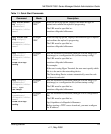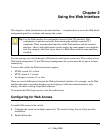
2-1
v1.1, May 2006
Chapter 2
Using the Web Interface
This chapter is a brief introduction to the web interface — it explains how to access the Web-based
management panels to configure and manage the system.
You can manage your switch through a Web browser and Internet connection. This is referred to as
Web-based management. To use Web-based management, the system must be set up for in-band
connectivity.
To access the switch, the Web browser must support:
• HTML version 4.0, or later
• HTTP version 1.1, or later
• JavaScript
(TM)
version 1.2, or later
There are several differences between the Web and terminal interfaces. For example, on the Web
interface the entire forwarding database can be displayed, while the terminal interface only
displays 10 entries starting at specified addresses.
To terminate the Web login session, close the web browser.
Configuring for Web Access
To enable Web access to the switch:
1. Configure the switch for in-band connectivity. The switch Getting Started Guide provides
instructions.
2. Enable Web mode:
Tip: Use the Web interface for configuration instead of the CLI interface. Web
configuration is quicker and easier than entering the multiple required CLI
commands. There are equivalent functions in the Web interface and the terminal
interface—that is, both applications usually employ the same menus to accomplish a
task. For example, when you log in, there is a Main Menu with the same functions
available.


















